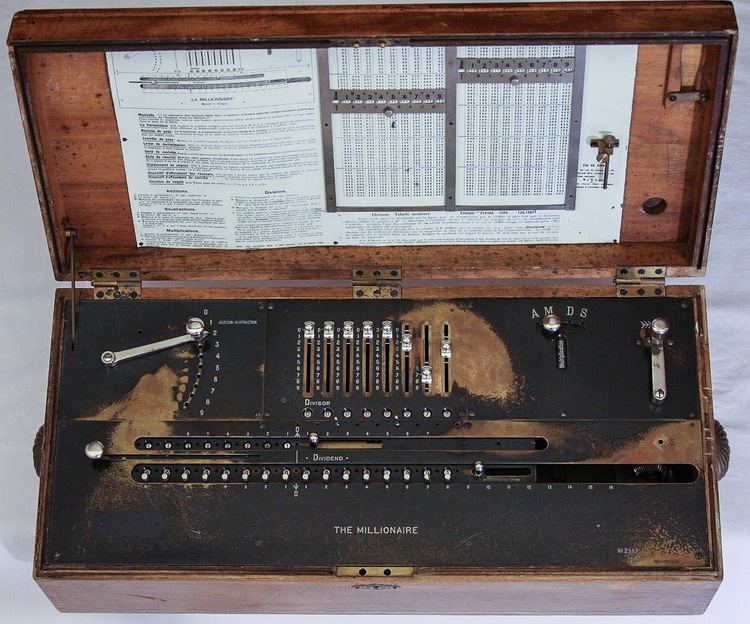 | ||
The Millionaire calculator was the first commercially successful mechanical calculator that could perform a direct multiplication. It was in production from 1893 to 1935 with a total of about five thousand machines manufactured.
Contents
History
Principle of calculation machine with progressive transmission of tens was invented by Chebyshev and demonstrated on World's fair 1878 in Paris. In 1881 Chebyshev demonstrated the model of calculation machine with automatic multiplication but did not take out a patent for it.
In 1834 Luigi Torchi of Milan invented a direct multiplication machine. First patented multiplying machines was due to Edmund Barbour (1872), Ramón Verea (1878) and Léon Bollée (1889). Bollée machine could be considered the direct ancestor of Millionaire.
Designed by Otto Steiger, a Swiss engineer, the moving carriage of the Millionaire has a 20 decimal digit accumulator that shows the product after multiplication and into which dividend is entered prior to division. The 10-digit multiplicand or divisor is entered on the sliders (or keyboard, on later models) above the carriage, while successive digits of the multiplier or quotient are entered with a push-button lever on the upper left. A large control knob on the upper right can be set to add, multiply, divide or subtract positions.
The Millionaire was first patented in Germany in 1892. Patents were issued in France, Switzerland, Canada and the USA in 1893, and production started in 1893. From 1899 to 1935 Hans W. Egli of Zürich handled the machine. The American agent for the Millionaire was W. A. Morschhauser of New York. During this long life, 4,655 "Millionaire" machines were sold.
The Millionaire was advertised as being the "only calculating machine on the market ... that requires but one turn of the crank ... for each figure in the multiplier or quotient," making it the fastest calculator available. Advertising from 1913 claims that the United States government had purchased over 100 Millionaire calculators.
Competition
All mechanical calculators commercialized prior to the Millionaire, like the arithmometer, the Odhner arithmometer or the comptometer were simple adding machines; they implemented multiplication by continued addition under operator control. In 1889, Léon Bollée, in France, invented a machine that required only one turn of the crank handle to multiply the number entered on the sliders by a multiplier number. This was accomplished by creating a mechanical representation of the multiplication table which could be read and used by the machine. The manufacturing cost of Bollée's machine was too high and the production was discontinued after a few units. The Millionaire was built with the same target of direct mechanical multiplication in mind.
In first decades of 20th century two other machines with direct multiplication were produced: the Moon-Hopkins and Kuhrt-US. These two companies were then taken over by Burroughs and Brunsviga. These machines filled quite a different niche from the Millionaire. They were book-keeping machines with printing features, and were too unwieldy to perform divisions and complex computations. The Millionaire, however, was better suited for technical computations.
This machine was very big and heavy and occupied an entire desk. Its size made it awkward to operate.
It was commercialized as "The Millionaire" in English speaking countries, "La Millionnaire" in French and "Millionär" in German speaking countries.
